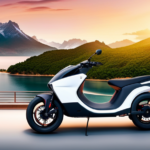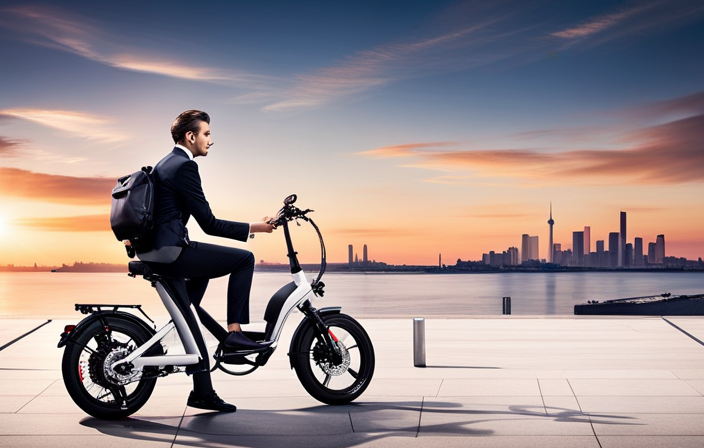Imagine soaring through the city streets, effortlessly gliding past traffic, all while reducing your carbon footprint. Electric bikes offer a thrilling and eco-friendly alternative for daily commuting.
But how far can you really go on an electric bike? In this article, we will explore the factors that determine electric bike range, provide tips for maximizing your bike’s range, and share real-life stories of electric bike commuters.
Get ready to embark on a journey that will revolutionize your daily commute and leave you craving for more.
Key Takeaways
- Range refers to the distance an electric bike can travel on a single charge.
- Battery capacity is the most significant factor affecting range.
- Other factors include rider and cargo weight, terrain, wind resistance, and motor assistance level.
- Choosing an efficient route, considering weather conditions, and planning for potential charging stations can help maximize the electric bike’s range during the commute.
Understanding Electric Bike Range
You’ll want to know how far you can commute on an electric bike. Calculating range is an important aspect when choosing an electric bike for your daily commute.
The range of an electric bike refers to the distance it can travel on a single charge. Several factors affect the range of an electric bike. The most significant factor is the battery capacity, measured in watt-hours. A higher capacity battery will provide a longer range.
Other factors include the weight of the rider and cargo, the terrain, wind resistance, and the level of assistance provided by the motor. By considering these factors, you can estimate the range of an electric bike.
Understanding the factors affecting range is crucial in choosing the right electric bike for your commute without compromising on distance covered.
Choosing the Right Electric Bike for Your Commute
When choosing the right e-bike for your daily travel, it’s important to consider the distance you need to cover. Electric bike features play a crucial role in determining the range it can cover on a single charge.
Here are five reasons why an electric bike is a great choice for your commute:
- Efficiency: Electric bikes are incredibly efficient, allowing you to cover more distance with less effort.
- Cost-effectiveness: Compared to other modes of transportation, electric bikes are much more affordable in terms of maintenance and fuel costs.
- Environmentally friendly: Electric bikes produce zero emissions, making them a sustainable choice for commuting.
- Flexibility: With an electric bike, you can easily navigate through traffic and find parking, saving you time and frustration.
- Health benefits: Riding an electric bike provides exercise and improves cardiovascular health.
By considering these factors, you can choose the right electric bike that suits your commuting needs.
Now, let’s explore some tips for maximizing your electric bike’s range.
Tips for Maximizing Your Electric Bike’s Range
To get the most out of your e-bike’s range, there are a few tips you can follow.
Maximizing battery life is crucial, and one way to do this is by properly charging your electric bike. Always use the charger that comes with your bike and avoid using third-party chargers, as they may not be compatible and could damage the battery.
It’s also important to charge your bike regularly, even if you haven’t used it much, to keep the battery healthy. Avoid letting the battery completely drain and aim to keep it between 20% and 80% charge.
Additionally, storing your bike in a cool and dry place can help prolong the battery life. By following these proper charging techniques, you can ensure that your e-bike’s battery lasts longer and provides you with a greater range.
Now, let’s talk about planning your electric bike commute…
Planning Your Electric Bike Commute
Plan your e-bike ride to work by considering the route, traffic patterns, and potential charging stations along the way. When bike route planning, it’s important to choose a route that is efficient and avoids heavy traffic. This will help conserve the battery and maximize your range. Additionally, consider the weather conditions for your commute. Wind and rain can significantly affect your electric bike’s range, so it’s important to plan accordingly. To assist you in planning your route and tracking your battery usage, use the table below:
| Mileage | Battery Level |
|---|---|
| 0 | 100% |
| 5 | 80% |
| 10 | 60% |
| 15 | 40% |
By taking these factors into account, you can ensure a smooth and successful commute on your electric bike. In the next section, we will discuss safety and legal considerations to keep in mind during your ride.
Safety and Legal Considerations
It’s important to consider safety and legal considerations during your ride on an e-bike.
When it comes to safety regulations, it’s crucial to familiarize yourself with the laws in your area. Different regions may have specific requirements, such as speed limits, helmet laws, and age restrictions. Additionally, some areas may require you to have a valid driver’s license or permit to operate an electric bike. Understanding these regulations will help ensure that you are riding legally and responsibly.
Another aspect to consider is insurance requirements. While not all areas mandate insurance for e-bike riders, it is still advisable to protect yourself and your investment by obtaining coverage. This will provide financial protection in case of accidents, theft, or damage to your electric bike.
Moving forward, let’s delve into the next section about maintenance and care for your electric bike.
Maintenance and Care for Your Electric Bike
Taking proper care of your e-bike is essential for its longevity and performance. Regular maintenance and proper handling can ensure that your electric bike continues to run smoothly and efficiently. Here are some maintenance tips to keep in mind.
Firstly, make sure to keep your e-bike clean by regularly washing it with mild soap and water.
Additionally, check the tire pressure regularly and adjust it as needed to ensure optimal performance.
It is also important to periodically inspect the brakes, gears, and chain to ensure they are properly lubricated and functioning properly.
If you encounter any issues, consult the troubleshooting guide provided by the manufacturer.
By following these maintenance tips, you can keep your e-bike in top condition and enjoy the benefits of electric bike commuting seamlessly.
Benefits of Electric Bike Commuting
One of the advantages of using an e-bike for transportation is the time saved on your daily travel. With an electric bike, you can easily navigate through traffic and reach your destination faster than you would with a traditional bicycle or a car. Not only does this save you time, but it also contributes to improving sustainability by reducing the amount of time spent idling in traffic and emitting harmful pollutants.
Additionally, electric bike commuting offers significant cost savings compared to other modes of transportation. You can save money on fuel, parking fees, and maintenance costs. Moreover, the cost of charging an electric bike is significantly lower than that of fueling a car. By choosing electric bike commuting, you not only benefit yourself but also contribute to a greener environment and enjoy substantial cost savings.
Now, let’s dive into some real-life stories of electric bike commuters.
Real-Life Stories: Electric Bike Commuters
Many people have shared their experiences of using e-bikes for their daily transportation. These real-life stories highlight the numerous benefits of electric bike commuting. From saving money on fuel and parking fees to reducing carbon emissions and improving physical health, the advantages are undeniable. To provide a visual representation of these ideas, the following table illustrates five key benefits of electric bike commuting:
| Benefit | Description |
|---|---|
| Cost-saving | Electric bikes require less maintenance and are cheaper to operate than cars or motorcycles. |
| Environmental-friendly | E-bikes produce zero emissions and contribute to a greener environment. |
| Health improvement | Regular cycling improves cardiovascular health and promotes overall fitness. |
| Time-saving | Electric bikes allow riders to navigate through traffic more efficiently, reducing commute time. |
| Enjoyable experience | Electric bike commuting offers a fun and enjoyable way to travel to work or run errands. |
These real-life experiences and benefits demonstrate why more and more people are choosing electric bike commuting as their preferred mode of transportation. Transitioning to the subsequent section about overcoming challenges of electric bike commuting, one must consider certain obstacles that may arise.
Overcoming Challenges of Electric Bike Commuting
To successfully navigate the challenges of e-bike commuting, riders must be prepared to address various obstacles that may arise. Here are some key strategies to overcome weather challenges and find charging stations:
-
Invest in proper gear: Rain or shine, having waterproof clothing and accessories will ensure a comfortable ride.
-
Plan your route: Research bike-friendly roads and alternate routes to avoid busy traffic or hazardous conditions.
-
Check the weather forecast: Stay informed about the weather conditions to make adjustments to your commute if needed.
-
Carry a portable charger: Finding charging stations can be challenging, so having a portable charger handy will eliminate range anxiety.
-
Join a community: Online forums or local biking groups can provide valuable information about charging stations and weather conditions specific to your area.
By addressing these challenges head-on, e-bike commuters can enjoy a smooth and hassle-free ride.
Looking towards the future, let’s explore the conclusion and future of electric bike commuting.
Conclusion and Future of Electric Bike Commuting
In conclusion, the future of e-bike commuting looks promising as more people embrace this sustainable and convenient mode of transportation. As we look ahead, future advancements in electric bike technology will further enhance the overall commuting experience. Manufacturers are constantly improving battery life, making it possible for commuters to travel longer distances without worrying about running out of power. Additionally, advancements in lightweight materials will make electric bikes even more efficient and easier to handle.
An important aspect of the future of e-bike commuting is its environmental impact. With the increasing concern for climate change, electric bikes offer a greener alternative to traditional modes of transportation. By reducing our reliance on fossil fuels and emitting zero tailpipe emissions, e-bikes have the potential to significantly contribute to a cleaner and healthier environment. Furthermore, as more people choose to commute by electric bike, we can expect to see a decrease in traffic congestion and air pollution in urban areas.
Overall, the future of e-bike commuting holds great potential for a more sustainable and eco-friendly transportation system.
Frequently Asked Questions
Can I use an electric bike for long-distance commuting?
Yes, an electric bike can be used for long-distance commuting. With an average electric bike range of 40-60 miles, it provides a convenient and eco-friendly mode of transportation for extended travel distances.
How does the range of an electric bike compare to a traditional bike?
The electric bike range typically surpasses the range of a traditional bike. While a traditional bike relies solely on human power, an electric bike can cover greater distances due to its electric motor assistance.
Are there any restrictions or regulations for using electric bikes for commuting?
There are regulations and restrictions for using electric bikes for commuting. These vary by location but commonly include speed limits, age restrictions, and requirements for helmets and lights. It is important to familiarize oneself with local laws before using an electric bike for commuting.
What are some common challenges that electric bike commuters face?
Common challenges electric bike commuters face include limited battery range, lack of charging infrastructure, inclement weather conditions, safety concerns, and the physical exertion required for longer distances. These challenges can impact the overall feasibility and convenience of electric bike commuting.
What are the environmental benefits of using an electric bike for commuting?
Using an electric bike for commuting has environmental benefits such as reducing carbon emissions and promoting sustainable transportation. By choosing this mode of transportation, I contribute to a cleaner and greener environment.
Conclusion
In conclusion, the future of electric bike commuting looks promising. With the advancements in technology and the increasing popularity of electric bikes, more and more people are discovering the benefits of this eco-friendly mode of transportation.
From reducing carbon emissions to saving money on fuel costs, electric bike commuting presents a sustainable and practical solution for daily travel.
As we continue to improve battery technology and expand charging infrastructure, the range of electric bikes will only increase, making them an even more viable option for commuters.
So hop on your electric bike and join the movement towards a greener future!
















